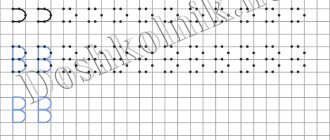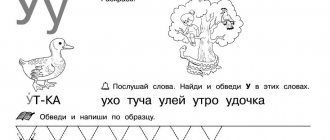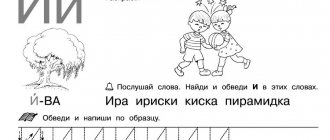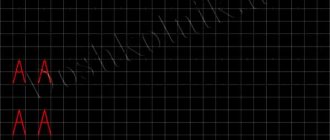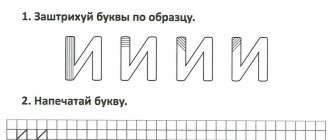A little bit of history
Y, or I short, as this letter in the alphabet is called, is known in many Slavic languages: Russian, Ukrainian, Belarusian; in Serbia and Macedonia, the letter J is used to indicate the sound Y.
In non-Slavic languages that use Cyrillic writing, this letter is also present.
In Russian, this letter is the 11th letter.
The sound Y was formed on the basis of the non-syllabic vowel “I” and the similar voiced consonant “J”.
Thus, the sound Y really combines a vowel and a consonant.
In the Bulgarian and Ukrainian languages, the letter Y is still used in the combination “YO”, which is intended to denote the letter E.
The letter Y arose in Church Slavonic writing in the 15th and 16th centuries. In the 17th century, during the time of Patriarch Nikon Y, it was already included in the publication of books in Church Slavonic in Moscow.
At the beginning of the 18th century, the so-called civil script was introduced. Superscript signs in Slavic writing were eliminated, and the letter Y was removed from the alphabet, although the sound remained in the language.
During the time of Peter the Great in 1735, Y was rehabilitated and appeared again in writing, but it was not included in the alphabet and did not represent any numbers (previously, numbers were designated by letters of the Church Slavonic alphabet). Already in the 20th century, the letter Y finally became part of the alphabet, but still remained somewhat “disregarded in its rights.” It was not included in the letter designations of the lists, and sometimes the tail above the letter in the letter is skipped, as are the dots above the e.
In the 18th and 19th centuries, the letter Y was already part of the Ukrainian and Belarusian alphabet. In Ukrainian it is called “ii”, which once again demonstrates its dual origin.
Learning to read and write “Sounds [i], [th] and letters I, J”
Let's start our Internet lesson with a fairy tale...
“One boy drew a forest animal with long ears, large hind legs and a small tail. And he wrote down the name of the animal so that no one would doubt it. This is where the miracles began... The animal suddenly spoke!...
-Be - be - disgrace! - he said.
-Why is it disgraceful? -Ko – ko – of course! - the animal got angry. The boy was surprised: -What's the matter? Now you're bleating like a sheep, now you're clucking like a chicken... - Moo-moo-moo - you're a reader, that's who! - the animal hummed. - What did you do to me? -Nothing. Did I draw you poorly? -No, you can find out. -So what's the deal? -Z – why did you make me for – for – stuttering? I'm not a stutterer.
The boy caught himself and drew another tail, but this time to the letter I. And the animal stopped stuttering. “Thank you,” he said. – Now everyone knows that I am….
- Can you guess who the boy drew? What letters did the boy mix up?
So today we will get acquainted with these sounds and letters. The sounds are different. Compare: needle and yogurt.
What is the first sound in the word “needle”? What sound is this?... Yes, the sound [and] is a vowel sound
What is the first sound in the word "yogurt"? What are the features of the sound [th'] ? (consonant, soft, voiced).
Remember! The sound [th'] is ALWAYS SOFT and sonorous!
1. Think of words with the sound [th'] at the beginning (iod, yogi, iota), in the middle (t-shirt, watering can, snake), at the end of the word (may, tea, edge).
2. Change the words so that they denote a request, an order, an incentive to action: stands (stand), washes (my), builds (build), sings (sing), decides (decide), plays (play), repeats (repeat ), floats (swim), thinks (think).
3. Listen to the words , say where and in what position the sound [th'] : strong, jockey, puck, iodine, ruler.
4. Clap your hands once if you hear the sound [th'] in the words: fox, husky, player, face, washbasin, nightingale, bus, trolleybus, scissors, car, snake, name, tea.
How strange, the sounds are different, but the letters are almost written very, very similar. Don't get confused! It is very important to read words correctly; replacing one letter will change the meaning of the word. So that the bunny doesn't turn into a bunny ...
5. Say the word
The house on rails is right here,
He will kill everyone in five minutes. Sit down and don't yawn. Departs... (tram).
***
The doctor lives in a glass jar. He treats sores and wounds. “Oh, how it stings!”, “Oh, how it burns!” Do you recognize? This is... (iodine)
In winter the mosquitoes have fallen asleep, the bear is sleeping in its den, and somewhere in the jungle they are languishing from the heat... (yogis)
***
Guess what we sang? “Kara...” (wai). Guess what they sang to us? “Bai...” (bye). What month is it, guess?
The month of May). What's in the glass, guess? Sweet... (tea) Meet the letter I and the letter Y !
1. Look carefully at the letters, find similarities and differences.
2. Find the hidden letters I and Y. Circle them.
3. Identify the letter in the wrong position.
4. Repair the letters:
5. Highlight a familiar letter.
6. Color only those cubes on which the letter Y .
7. Color both letters I in red on the right side of the picture. Shade the letter according to the pattern in the middle of the picture. Find and color the letter I on the right side of the picture.
8. Color both letters green. Shade it. Find and color the letter Y.
9 . Connect with the letter And only those objects whose names begin with the sound [and] .
10 . Connect with the letter Y only those objects whose names begin with the sound [th'] .
11. Underline the same letter as below in the picture on the left. Circle all the letters I in the picture on the right.
12.
Letter Y
The name is “And short”
and
like I in your notebook.
So as Y
with I, write a tick at the top.
Take a green pencil and color in all the parts of the drawing in which you see the letters Y.
13. We are writing...
Learn to write beautifully here
14.
Dictionary
- Illusion - fiction, fantasy
- Illusionist - magician
- Image - the “image” of a product, service, enterprise, person
- Immunity is the body's defense reaction
- An empire is a powerful power that unites different peoples and territories into a single state
- Intelligence - mind
- Hippodrome is a sports complex for equestrian competitions.
- Research is an action in which scientists study a phenomenon.
- Iodine is a chemical element.
- Yoga is a physical exercise to keep fit. This is a special lifestyle and way of thinking.
Catchphrases or phraseological units
- To play the first violin is to play a leading role in any matter; to be a leader, a ringleader.
- Playing with fire means taking risks.
- To follow in someone's footsteps is to imitate someone; follow someone's example.
- Going against the grain - doing something contrary to those around you.
- To pour out your soul is to tell someone about something most intimate and personal.
- Looking for a needle in a haystack means looking among a large volume; to look for something that is obviously impossible to find.
- Sparks flew from the eyes - indicating the consequences of a strong blow.
I recommend reading:
- 77 Effective Educational Techniques
- Interesting...Great people who changed the world
- Holiday "Farewell, ABC!" (scenario)
- Online lesson on literary reading “M. Lermontov "Borodino"
Tags: Online Russian language reading
Which sound?
And yet, when classifying sounds, it is not entirely clear which sound Y is a vowel or a consonant.
It’s worth answering right away: neither one nor the other.
Let's try to think.
The Y sound is not dull, which can be easily felt when pronouncing this sound.
It is rather sonorous, as it is pronounced with the participation of the voice. However, it is not a vowel sound, since any vowel can be sung without difficulty.
Try to sing the sound Y: you are unlikely to succeed. In this regard, although the voice is involved in the formation of this sound, it is still a consonant.
This is how philologist teachers qualify it in school practice.
However, the sound Y is not voiced. According to the classification of philologists, a consonant sound can be classified into one of four groups: voiceless, hissing, voiced or sonorant. Let's talk about the last group of sounds in more detail.
A consonant sonorant sound is located in its characteristics between vowels and consonants, but it is still designated as a consonant.
There are few sonorant sounds in the Russian language: N, R, L, Y, M. They can be pronounced with the voice, but they cannot be sung as a vowel sound.
Thus, the sound Y is a sonorant consonant.
Another question that may arise is whether the letter Y is soft or hard.
Most sounds have pairs of softness and hardness. The sound Y does not have such a pair.
It is qualified by scientists as always soft.
In the transcription of a word, there is always a symbol of softness next to it.
Sound automation
Exercises for automating the sound Y: isolated, in syllables, words and sentences.
Automation of the sound Y, starts with the easiest tasks.
Say the sound Y repeatedly.
Automation in combinations with vowels:
Ya, yo, yo, ya.
Repeat:
ah, oh, hey, oh.
Say pairs and chains:
a – I, I – La, I – I – La
o - e, e - le, le - le - e
u - yu, yu - lyu, yu - lyu - yu
e-e, e-le, le-e-le
Automation in words:
Y at the beginning of a word
Yo-yo, iodine, iodoform, yot, iota, Yemen, Yemeni, yogurt, yogurt, Yorkshire.
Ya (Ya)
I, lizard, appear, obvious, sycamore, appear, appear, reality, reindeer moss, moss moss, berry, buttock, berry, poison, nuclear, nuclear scientist, core, sneak, sneak, sneak, apple, apple tree, apple, ide, supposedly, barren, pit, Yankee, bright, bright, brightness, rage, furious, tier, ardent, ash, manger, clear, clarity, clear, hawk, yacht.
Yo (Yo)
Hedgehog, hedgehog, shiver, yoke, tree, herringbone, capacious, capacity, fidget, yornik, squirm, ruff.
Ye (E)
Food, Jew, European, huntsman, Egypt, Egyptian, Europe, his, fidget, fidget, food, barely, unit, unicorn, unity, single, eater, her, blackberry, annual, caustic, if, hedgehog, hedgehog, hedgehog, ride.
Yu (Yu)
Southerner, yuz, yukola, yula, bustle, humor, humoresque, humorist, cabin boy, youth, junior, cadet, yunnat, youth, young man, young, jupiter, lawyer, yurk, nimble, yurknut, holy fool, foolishness, yurok, yurt.
Y in the middle of a word
Alpine, English, anxiety, eat into, entrance, drive in, drive in, abscess, devil, travel, expression, reveal, flaw, explain, interview, bloodhound, border, watering can, ruler, T-shirt, seagull, flock, whaling, brand, sticky, combine, kopeck, superstructure, find, find, combine, detour, go around.
Y end of the word
yY
Active, silent, homeless, carefree, selfless, toothless, defenseless, unresponsive, joyless, rootless, mongrel, windy, vertical, cheerful, platoon.
iY
armless, great, Hungarian, evening, prophetic, weighty, future, bull, spring, third, flexible, tall, genius, rattling, Greek, Greek, graphic, distant, ladies', Danish.
Ouch
My, yours, spring, riding, windy, gross, second, sixth, seventh, hero, deaf, bay, rotten, blue, lip, home, trashy, living, evil, heat, dry, dear, private, fatal, residential, groovy, golden, what, indigenous, stingy, structure, stand, dumb, stuffed, naked, male, young, sea, world, passenger, oblique, crooked.
to her
pigeons, frost, glue, stream, children, babies, shorties, kings, mice, sparrows, sons, daughters, wheatgrass, nightingales, horses, bears, notebooks, nails.
yay
conjure, lackey, blow, march, risk, draw, pass, pamper, dance, steal, yearn, prance, pass, interpret, current, strike, pack, worry, coo, chop, chic, believe, I can, I know, I bathe, I moan, I lift, I read, I sneeze, I save, I shave, I wash, I sing, I stand.
So, is "th" a vowel or a consonant?
For several centuries, linguistics has been studying the sound structure of language and speech. This contributes to the emergence of new features for classifying and evaluating sounds.
To understand the identity of the letter “th”, it is necessary to pronounce it drawlingly. As if trying to sing this letter without replacing it with a similar “i”, you can make sure that this will not work. According to phonetic standards, this means that “th” is a consonant.
Individual vowels, when analyzed phonetically, can confuse the correct definition, since they have two sounds at the same time, “y” is one of them. These are the letters “ё” [yo], “yu” [yu], “ya” [ya] and they are called iotized. Such sounds appear immediately after the vowel, located in the first syllables or after the “ъ” or “ь” sign. As an example of iotized letters, here are a few words:
- fir-tree [jolka];
- monkey [abiz'jana];
- pit [jama];
- ate [pajel];
- rise [fall].
It should be noted that the sound “and short” is absent as such, since it is only a letter name. The sound is called “th”, or there is such a name – yot [j].
Origin of the letter "th"
In 2021, the letter “y” celebrates its centenary since its appearance in the Russian language alphabet. In 1918, linguistic reform made it possible to replace the then-current “i” with the now familiar “th”.
Academicians argued a lot about the belonging of letters to various sounds. This was facilitated by the historical reason where the used “i” was used in such cases where “and” is written, such as “mir” instead of “and”, or “th” is written, for example “major” replacing “th”. And disputes on this issue continued for many years.

